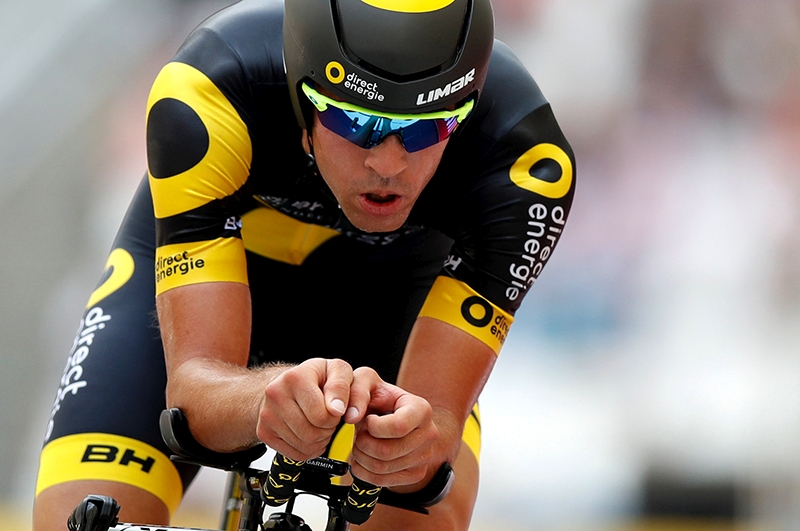Cyclists need to understand aerodynamic drag in order to beat it. Cycling coach Joe Beer gives the low-down on cycling aerodynamics and presents some of his own recently collected data.
Although cyclists have to overcome the forces of gravity and the rolling resistance of tyres on roads/moving components on the bike, once your speed exceeds around 15mph, it’s aerodynamic drag that becomes your main enemy. Drag is a frictional force caused by the turbulence of displacing air that is pushed out of the way as you pass through it. Pedalling along at 20mph requires the displacement of no less than 1000lbs of air per minute!
Aerodynamic drag increases as the square of velocity; if you double your speed, you will expend 4 times the energy to overcome drag. Expressed another way, for every increment of extra power you apply at the pedals, your increase in speed becomes progressively smaller. Eg, it requires 7.2 watts of power per mph to sustain 19mph on the flat; to sustain 30mph requires no less than 13.1 watts per mph!
Because energy-sapping aerodynamic drag is always present when cycling, learning how to minimise drag is vital for riding fast. Studies show that around one third of drag is caused by the bike, and two thirds by the rider, so reducing rider drag is the number one priority2. And the best way to achieve this is to hone the riding position so that maximum power can be achieved with minimum drag.
Aerodynamics and riding position
The optimum riding position will depend on the type of bike being ridden, but below are listed some of the best ways to reduce drag:• Try and keep the torso as flat as possible, ensuring the knees don’t hit the stomach or rib cage at the top of the pedal movement;
• Use aerobars to keep the forearms around 15-20cms apart and kept roughly horizontal;
• Ensure the knees stay close to the bike frame and don’t splay outwards;
• Tuck down on drop handlebars and adopt a 3 & 6 o’clock position with the feet on the pedals during long descents.
However, while the most aerodynamic position is rarely going to be the most comfortable, you should ensure that you’re still comfy enough to produce near maximum power, because it’s power that you need to overcome drag!
Tactics
It’s not just riding position that affects drag, but the tactics you use when you ride. Studies have demonstrated that if you can tuck in behind another rider and stay around 30cms from the back wheel, drag is reduced by around a fifth at 20mph3. The faster your riding speed, the greater the potential energy savings to be made. This explains why stage race riders only appear at the front of the pack at the end of stage; they shield themselves using other riders until their sprinting or climbing legs are needed.Equipment aerodynamics
Once you’ve addressed your riding position and tactics, you can think about equipment:• Bars - aerobars allow a narrower arm position and promote a horizontal torso, thereby reducing drag. Studies have shown that although aerobars slightly reduce pedalling efficiency (by around 9 watts), in elite cyclists, they can reduce wasted energy due to drag by up to 100 watts4. Even swapping standard handlebars for basic ‘cow-horn’ shaped bars (popular in the 90s) can reduce the amount of energy required to maintain a speed of 25mph by 7%;
• Helmets – can also make significant contributions to drag reduction. We recently conducted tests with industry experts and discovered that an aerodynamic helmet produced significant reductions in drag compared to a normal vented helmet. Our data revealed that at a power of 300 watts, a rider using an aero-helmet could travel over a mile further during an hour’s pedalling or, expressed another way, could chop around 2 minutes off a 25-mile time trial!
• Bike frames and wheels – over a 40km time trial, an aerodynamically designed frame can knock off upwards of a minute, and over 2 minutes for an elite cyclist5! Wheels can also contribute time savings; a box-rim with 20-30 spokes will cost an extra half minute or so over 40km compared to an aero ‘deep-dish’ or composite wheel5. As a rule of thumb, the lower the spoke count, the better; solid disk wheels with no spokes give the largest time savings;
• Clothing – can make a big difference to the amount of drag experienced. The lowest drag clothing is both tight fitting and has a low ‘surface drag’ as the air flows over it. For time trialling, a tight fitting one-piece suit without pockets (or other features that could flap around in the wind) is hard to beat. Road riders should at least ensure they wear a snug fitting top. Exotic purpose-designed suits (eg Nike’s Swift Spin suits) may offer the best performance of all, but they are expensive and rarely find their way onto the general market.
Summary
Minimising drag requires a combination of correct rider position, riding tactics and equipment. The first two strategies are cheap – a simple drop in stem height or addition of aerobars can knock minutes off a 25-mile time trial. Going ‘aero’ with your bike and its components on the other hand could cost hundreds or even thousands of dollars! However, never loose sight of the fact that while reducing drag is a worthwhile goal, it shouldn’t be at the expense of building a strong cycling engine. Remember, it’s power you need to overcome drag!References
1. Burke, E.R. 1991; Science of Cycling Human Kinetics. 0-87322-181-8
2. Gregor, R.J. & Conconi, F. 2000; Road Cycling – an IOC Medical Commission Publication
3. J. Appl. Physiol 1990; 68(2): 748-753
4. Blackwell Science. 0-86542-912-X
5. Martin, J & Cobb, J. (2002; ‘Bicycle Frame, Wheels and Tyres’ in High Performance Cycling (Jeukendrup, A.E.) HKPress. P. 113-127 0-7360-4021-8
Original article by Joe Beer, summary by Andrew Hamilton











